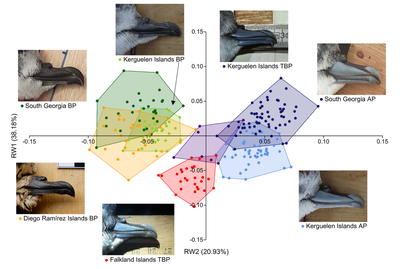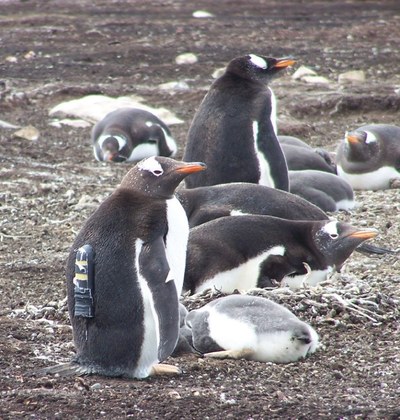Optimal foraging
Adaptations of pelagic seabirds to energy landscapes and their biogeographic environment
The efficiency of prey acquisition determines whether animals can successfully raise offspring while maintaining their own body condition and avoiding predation, i. e., whether they can achieve high fitness (measured as lifelong reproductive success). Therefore, to investigate inter- and intraspecific differences in morphological traits, a study1 compared the bill shape of three different petrel species (Procellariidae). Bill shape has implications for foraging efficiency. For the study, the bills of thin-billed prions (Pachyptila belcheri), blue petrels (Halobaena caerulea), and Antarctic prions (Pachyptila desolata) from different population locations were measured using geometric morphometric methods. Not only did this reveal significant interspecific differences in size, shape, and length, H. caerulea and P. desolata also showed intraspecific differences between different populations. For example, the bills of Antarctic prions from the Kerguelen Islands were longer and narrower than those of a population on Bird Island (South Georgia/Sandwich Islands). It can be assumed that the bill shapes are adaptations to the geographically different food supply and thus a form of niche differentiation.1

Fig. 1: Morphospace of the right profile of the bills of thin-billed prions (TBP), blue petrels (BP), and Antarctic prions (AP) of different populations; shape of the nares, size of the unguis maxillaris and mandibularis, and length of the culminicorn on the x-axis (RW1); bill depth and shape of the unguis maxillaris on the y-axis (RW2)1(Fig. 3: p. 7 modified)
There are also numerous studies of animal prey acquisition that focus on describing their spatial distribution. In contrast, the mechanisms that lead to this distribution have largely not been studied. This gap could be filled by using new methods in the analysis of animal movements. Habitat data can be blended with acceleration data of animal movements to calculate energetic costs of movements in potential prey space, and translate these into an energy landscape.
Gentoo penguins (Pygoscelis papua), known for their high flexibility in prey acquisition behaviour, are particularly suitable for such studies. As part of a study2, individuals from two separate breeding colonies on New Island (Falkland Islands) were therefore equipped with GPS-TD loggers and accelerometers over a period of two years, and isotope analyses of chick feathers were carried out. Energy landscapes created from the acquired data differed between years and colonies. They varied with variations in diving depth, hunting area and other parameters and also showed effects on breeding success.2
Therefore, in a further study3, the relationship between energy landscapes and population dynamics was explored in different environments. In addition to P. papua from New Island and Livingston Island (Antarctica), chinstrap penguins (P. antarctica) on Deception Island were equipped with GPS-TD loggers and accelerometers. Isotope analyses, molecular faecal analyses and blood analyses were also conducted. Gentoo penguins from Livingston Island, a site with positive population trends, foraged in energy landscape sectors that implied lower foraging costs per energy gained compared with those around New Island, a breeding site with fluctuating energy costs of foraging, breeding success and populations. Chinstrap penguins from Deception Island expended even less effort than Gentoo penguins from Livingston Island on their foraging trips, had less stress, and were in better physical condition. Their broods were also more successful. The lower foraging costs incurred by the gentoo penguins from Livingston, may favour a higher breeding success that would explain the species’ positive population trend in the Antarctic Peninsula. The lower foraging costs in chinstrap penguins may also explain their higher breeding success, compared to gentoos from Antarctica but not their negative population trend. Overall, the results were able to illustrate a relationship between energy landscape, foraging costs, stress, and physical condition that directly affects reproductive success and thus population dynamics. These results will help to understand how animals respond to different environmental conditions. This is particularly relevant in times of ever-changing conditions, such as those currently arising from the influences of climate change.3

References
1. Laranjeiro MI, Farré M, Phillips RA, Quillfeldt P, Bonadonna F, Gémard C, Daigre M, Suazo CG, Barbraud C, Navarro, J. (2022). Variation among species and populations in bill shape and size in three planktivorous petrels. Marine Biology, 169: 1-12. DOI:https://doi.org/10.1007/s00227-021-04014-7.
https://link.springer.com/article/10.1007/s00227-021-04014-7
2. Masello JF, Kato A, Sommerfeld J, Mattern T, Quillfeldt P (2017): How animals distribute themselves in space: variable energy landscapes. Frontiers in Zoology, 14: 33. DOI:https://doi.org/10.1186/s12983-017-0219-8.
https://frontiersinzoology.biomedcentral.com/articles/10.1186/s12983-017-0219-8
3. Masello JF, Barbosa A, Kato A, Mattern T, Medeiros R, Stockdale JE, Kümmel MN, Bustamante P, Belliure J, Benzal J, Colominas-Ciuró R, Menéndez-Blázquez J, Griep S, Goesmann A, Symondson WOC, Quillfeldt P (2021): How animals distribute themselves in space: energy landscapes of Antarctic avian predators. Movement Ecology 9: 24. DOI: 10.1186/s40462-021-00255-9.
https://movementecologyjournal.biomedcentral.com/articles/10.1186/s40462-021-00255-9
